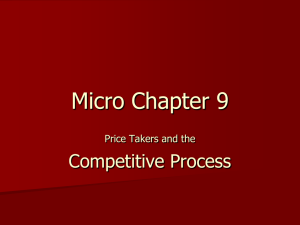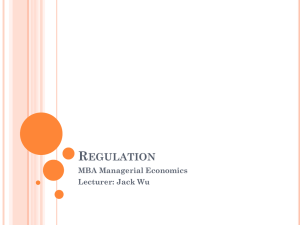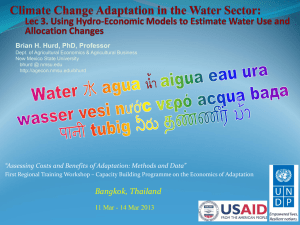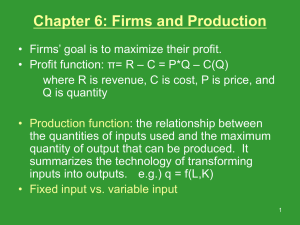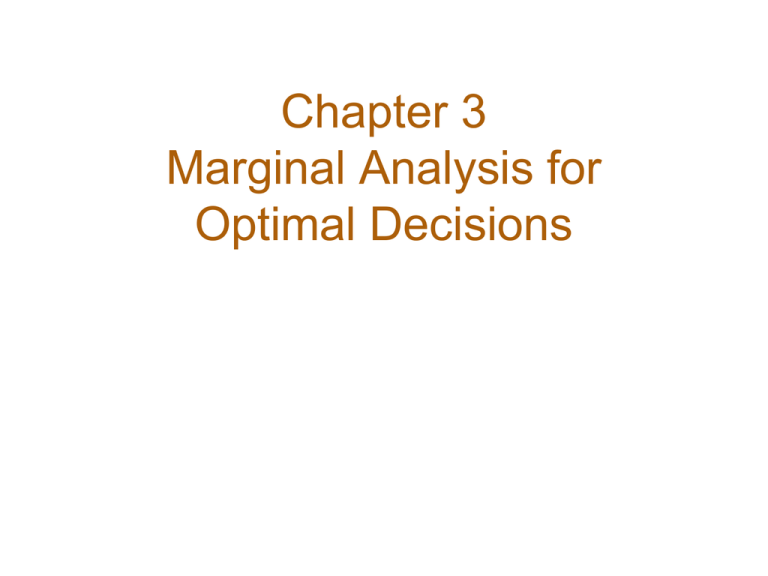
Chapter 3
Marginal Analysis for
Optimal Decisions
McGraw-Hill/Irwin
Copyright © 2013 by The McGraw-Hill Companies, Inc. All rights reserved.
Learning Objectives
•
•
•
Define several key concepts and terminology related to
marginal analysis
Use marginal analysis to find optimal activity levels in
unconstrained maximization problems and explain why
sunk costs, fixed costs, and average costs are irrelevant
for decision making
Employ marginal analysis to find the optimal levels of
two or more activities in constrained maximization and
minimization problems
3-2
Optimization
• An optimization problem involves the
specification of three things:
- Objective function to be maximized or
minimized
- Activities or choice variables that determine
the value of the objective function
- Any constraints that may restrict the values of
the choice variables
3-3
Optimization
• Maximization problem
- An optimization problem that involves
maximizing the objective function
• Minimization problem
- An optimization problem that involves
minimizing the objective function
3-4
Optimization
• Unconstrained optimization
- An optimization problem in which the decision
maker can choose the level of activity from an
unrestricted set of values
• Constrained optimization
- An optimization problem in which the decision
maker chooses values for the choice
variables from a restricted set of values
3-5
Choice Variables
• Activities or choice variables determine
the value of the objective function
• Discrete choice variables
- Can only take specific integer values
• Continuous choice variables
- Can take any value between two end points
3-6
Marginal Analysis
• Analytical techniques for solving
optimization problems that involves
changing values of choice variables by
small amounts to see if the objective
function can be further improved
3-7
Marginal Benefit & Marginal Cost
• Marginal benefit (MB)
- Change in total benefit (TB) caused by an
incremental change in the level of the activity
• Marginal cost (MC)
- Change in total cost (TC) caused by an
incremental change in the level of the activity
3-8
Marginal Benefit & Marginal Cost
Change in total benefit TB
MB
Change in activity
A
Change in total benefit TC
MC
Change in activity
A
3-9
Relating Marginals to Totals
• Marginal variables measure rates of
change in corresponding total variables
- Marginal benefit (marginal cost) of a unit of
activity can be measured by the slope of the
line tangent to the total benefit (total cost)
curve at that point of activity
3-10
Using Marginal Analysis to Find
Optimal Activity Levels
• If marginal benefit > marginal cost
- Activity should be increased to reach highest
net benefit
• If marginal cost > marginal benefit
- Activity should be decreased to reach highest
net benefit
3-11
Using Marginal Analysis to Find
Optimal Activity Levels
• Optimal level of activity
- When no further increases in net benefit are
possible
- Occurs when MB = MC
3-12
Unconstrained Maximization with
Discrete Choice Variables
• Increase activity if MB > MC
• Decrease activity if MB < MC
• Optimal level of activity
- Last level for which MB exceeds MC
3-13
Irrelevance of Sunk, Fixed, and
Average Costs
• Sunk costs
- Previously paid & cannot be recovered
• Fixed costs
- Constant & must be paid no matter the level
of activity
• Average (or unit) costs
- Computed by dividing total cost by the
number of units of activity
3-14
Irrelevance of Sunk, Fixed, and
Average Costs
• Decision makers wishing to maximize the
net benefit of an activity should ignore
these costs, because none of these costs
affect the marginal cost of the activity and
so are irrelevant for optimal decisions
3-15
Constrained Optimization
• The ratio MB/P represents the
additional benefit per additional dollar
spent on the activity
• Ratios of marginal benefits to prices of
various activities are used to allocate a
fixed number of dollars among activities
3-16
Constrained Optimization
• To maximize or minimize an objective
function subject to a constraint
- Ratios of the marginal benefit to price
must be equal for all activities
- Constraint must be met
MBA MBB MBC
MBZ
...
PA
PB
PC
PZ
3-17
Example
MBta
MBct
MBsp
MBad
=
=
=
Pta
Pct
Psp
Pad
Pta = $15,000
Pct = $30,000
Psp = $35,000
Pad = $50,000
30,000
$15,000
2
=
=
ta – teacher aid
ct – certified teacher
sp – Specialist
ad – Administrator
MBta = 30,000
MBct = 70,000
MBsp = 70,000
MBad = 90,000
70,000
=
$30,000
2.33 =
70,000
$35,000
2
=
=
90,000
$50,000
1.8
The next person hired should be a: Certified Teacher
3-18





